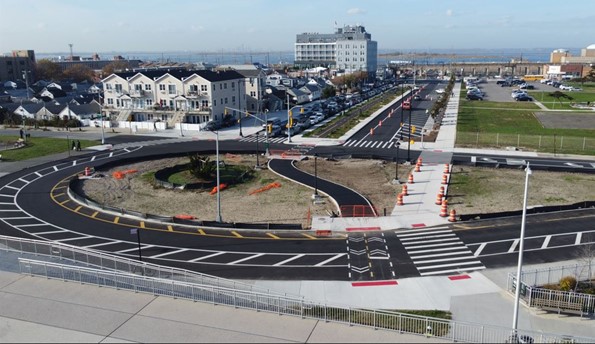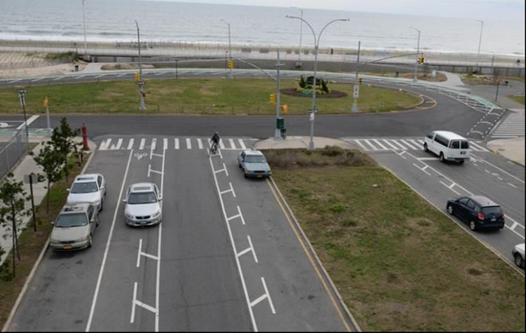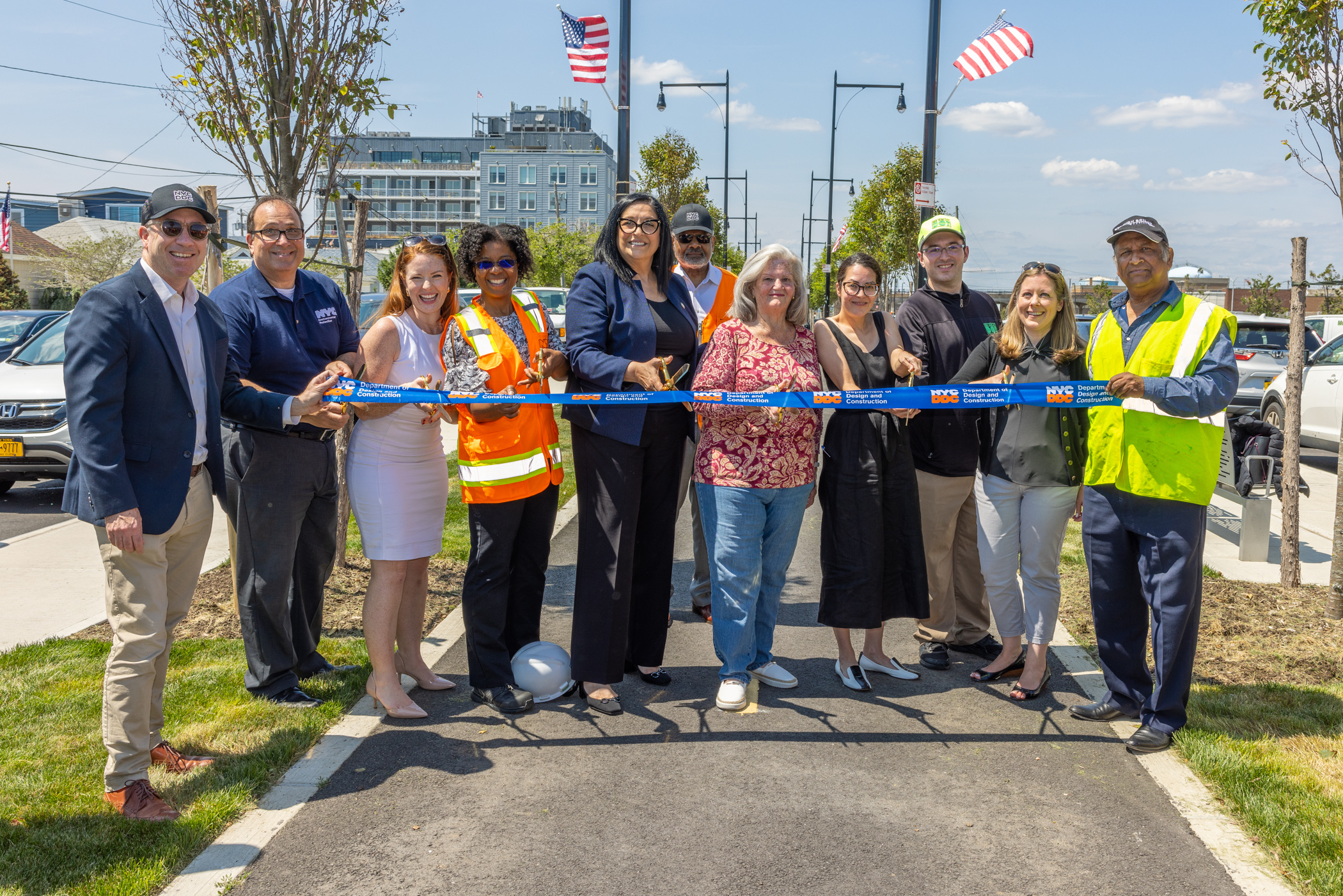
 Department of Design and Construction311
Department of Design and Construction311 Search all NYC.gov websites
Search all NYC.gov websites
City Completes Reconstruction of Rockaway Corridor with Dramatic Safety Upgrades, New Porous Pavement for Improved Drainage
Redesigned corridor includes grade-separated bike lanes, expanded pedestrian space, enhanced traffic safety
New porous pavement will allow nearly 1.3 million gallons of stormwater to be absorbed into the ground each year, reducing flooding
DEP: 718-595-6600, DEPPressOffice@dep.nyc.gov
DOT: 212-839-4850, press@dot.nyc.gov
DDC: Ian Michaels, 646-939-6514, michaelia@ddc.nyc.gov

(Rockaway, NY – June 13, 2023) The NYC Department of Environmental Protection (DEP), NYC Department of Transportation (DOT), NYC Department of Design and Construction (DDC) and the Mayor’s Office of Climate & Environmental Justice (MOCEJ) today joined Councilmember Joann Ariola and the New York State Office of Resilient Homes and Communities to announce the completion of a $16.6 million infrastructure project that rebuilt Beach 108th Street in Rockaway, Queens from Beach Channel Drive to Shore Front Parkway. The reconstruction included a redesign that improves traffic safety for all road users, better accommodating increased pedestrian and cycling traffic generated by the nearby NYC Ferry landing, and new, porous pavement that will allow nearly 1.3 million gallons of stormwater to be absorbed into the ground each year, which will ease pressure on the sewer system, help to reduce flooding and improve the health of Jamaica Bay.
“By including porous pavement in this reconstruction of Beach 108th Street, we are keeping more than a million gallons of stormwater out of the sewers each year which will reduce localized flooding and help protect the health of Jamaica Bay,” said NYC Chief Climate Officer and DEP Commissioner Rohit T. Aggarwala. “DEP’s stormwater regulations require new developments to manage the rain and snow that falls on them with Green Infrastructure, and we’ll be seeing much more of these types of projects in the coming years.”

"The new Beach 108th Street design brings high-quality, protected bike infrastructure from the boardwalk to the NYC Ferry landing—in addition to expanded pedestrian space and crosswalks. These changes improve safety for all road users and support safe, sustainable, and efficient transportation options for New Yorkers," said NYC DOT Commissioner Ydanis Rodriguez. "We thank Mayor Adams for his support as well as the work from DEP and DDC to deliver this great project right in time for the Rockaway Beach season."
“This $16.6 million project brings safer streets and innovative new stormwater management techniques such as porous concrete that absorbs water to a coastal area that was greatly affected by Superstorm Sandy,” said NYC Department of Design and Construction Commissioner Thomas Foley. “DDC is working with DEP and DOT to transform the City’s streetscape in every borough for safety and also resiliency. We will look to expand these methods to other neighborhoods as we manage the greater demands placed on us by climate change.”
“The stormwater drainage, pedestrian and roadway improvements to the Beach 108th Street corridor are examples of the Adams Administration’s commitment to making the city more resilient and sustainable for all New Yorkers,” said Victoria Cerullo, Acting Executive Director, Mayor’s Office of Climate & Environmental Justice. “These enhancements will address flooding, provide better and safer connectivity for Rockaway communities to and from the ferry, and offer safer and easier cycling.”
“The Beach 108th street improvements demonstrate the State’s commitment to ensuring New Yorkers are safe on their streets and more resilient to flood events. This project grew from a bottom-up, community led planning process following Superstorm Sandy and Rockaway residents should be proud their efforts have come to fruition. Thank you to all the City agencies for their partnership on this critical initiative,” said New York State Office of Resilient Homes and Communities Executive Director Katie Brennan.
“The people of Rockaway have been waiting a long time for this day,” Councilwoman Joann Ariola said. “At long last, we will finally have a safe, steady, and efficient flow of traffic here, and the area is now more resilient than ever before. Thank you to our partners at the DDC, DOT and everyone else who helped to make this happen.”

Beach 108 Street project details
The project helped rebuild an area damaged by Superstorm Sandy and its size triggered DEP stormwater regulations that require the use of Green Infrastructure. More than 11,000 square feet of new permeable concrete slabs that allow for natural stormwater drainage through the concrete and into the ground below have been installed along the curbline. Under DEP’s Unified Stormwater Rule, which took effect in 2022, the use of Green Infrastructure will be required in projects similar to this one citywide.
Under the project, which began construction in March 2021, approximately 1,100 feet of existing storm sewers and 22 catch basins were repaired or replaced and an additional 140 feet of new storm sewers plus three new catch basins were added. More than a mile of old concrete curbs were replaced along with adjacent sidewalks and more than 18,000 square yards of asphalt were laid down to pave the area. About 6,000 feet of old water mains were also replaced and two new fire hydrants were added.
In addition, a new 1,600-foot-long median was installed in the center of Beach 108th Street with a new two-way, grade-separated bike path, 58 new trees and new benches. The addition of angled parking added over 20 new parking spots to the community as well. The new design also delivered new and widened sidewalks, new crosswalks, and curb extensions at crossings and the local bus stop.
The new two-way bike path for the first time provides dedicated cycling connections between the ferry terminal and boardwalk. And wider sidewalks and new curb extensions improve pedestrian access and shorten crossing distances. New left turn phases were also installed to improve safety and traffic flow.
The project was initially conceived through a community-informed process sponsored by the State’s NY Rising Program. It was made possible through a City/State partnership between MOCEJ, DOT, DEP, DDC and the Governor’s Office of Storm Recovery, all working together to make the city more resilient and sustainable.
About the NYC Department of Transportation
The New York City Department of Transportation’s (NYC DOT) mission is to provide for the safe, efficient, and environmentally responsible movement of people and goods in the City of New York and to maintain and enhance the transportation infrastructure crucial to the economic vitality and quality of life of our primary customers, City residents. NYC DOT’s staff manage an annual operating budget of $1.4 billion and a ten-year $33 billion capital program, along with 6,300 miles of streets and highways, over 12,000 miles of sidewalk, and approximately 800 bridges and tunnels, including the iconic East River bridges. NYC DOT’s staff also installs and maintains nearly one million street signs, 13,250 signalized intersections, over 315,000 street lights, and over 350 million linear feet of markings.
About the NYC Department of Environmental Protection
DEP manages New York City’s water supply, providing approximately 1 billion gallons of high-quality drinking water each day to more than 9 million residents, including 8.3 million in New York City. The water is delivered from a watershed that extends more than 125 miles from the city, comprising 19 reservoirs and three controlled lakes. Approximately 7,000 miles of water mains, tunnels and aqueducts bring water to homes and businesses throughout the five boroughs, and 7,500 miles of sewer lines and 96 pump stations take wastewater to 14 in-city treatment plants. DEP has a robust capital program, with a planned $31.3 billion in investments over the next 10 years that will create up to 3,000 construction-related jobs per year. For more information, visit nyc.gov/dep, like us on Facebook, or follow us on Twitter.
About the NYC Department of Design and Construction
The Department of Design and Construction is the City’s primary capital construction project manager. In supporting Mayor Adams’ long-term vision of growth, sustainability, resiliency, equity and healthy living, DDC provides communities with new or renovated public buildings such as firehouses, libraries, police precincts, and new or upgraded roads, sewers and water mains in all five boroughs. To manage this $24 billion portfolio, DDC partners with other City agencies, architects and consultants, whose experience bring efficient, innovative and environmentally-conscious design and construction strategies to City projects. For more information, please visit nyc.gov/ddc.
About the Mayor’s Office of Climate & Environmental Justice (MOCEJ)
MOCEJ works to make our buildings efficient and resilient, ensure our infrastructure is climate-ready, transform our streets and public realm into living, open spaces, and make our energy clean and resilient. Through science-based analysis, policy and program development, and capacity building, and with a focus on equity and public health, MOCEJ leads the City’s efforts to ensure that New York City is both reducing its emissions and preparing to adapt and protect New Yorkers from the intensifying impacts of climate change.


